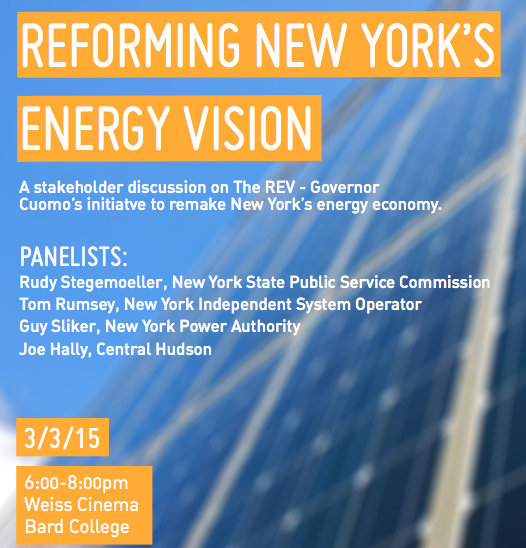Written by Kale Roberts MS ’16 Bard Center for Environmental PolicyJust sharing NY energy news, particularly about solar. Followinglast week’s whirlwind panel discussion about REV’s goals and utility/service provider/regulator restructuring, I remained a bit mystified about what concretely is going on in New York. For fun, here are a few blog-posty-type articles. The takeaway for me is that New York is attempting some very innovative approaches to creating a customer-centric, market-oriented electricity system of the future—even beating California in innovation (it needs that sometimes) in ways. And this may spell good things for solar power, customers wanting more control, and even utilities who of course want to (and will) remain in the game.Writing from Rocky Mountain Institute, Matthew Corsby and Dan Cross-Call highlight key differences between California’s and New York’s electricity sector transformation: while California has focused more on command-and-control mandates to force utilities to develop “distributed resources plans”, REV in New York seeks to instead harness market forces to encourage distributed power. California has a lot more solar power online already (New York is 9th in the nation for installed solar), and this relative urgency to act may explain why Cali is being a bit more top-down forceful than New York. In terms of solar specifically, New York’s relative lag may be an asset because the state is getting a head start to make room for more before it’s overwhelmed.Also in terms of solar, Tim McDonnell writes from Grist that “Under a new order from the state’s Public Service Commission, utility companies will soon be barred from owning ‘distributed’ power systems — that means rooftop solar, small wind turbines, and basically anything else that isn’t a big power plant.” McDonnell’s idea here is that utilities owning huge numbers of solar panels would undermine the role of smaller players. Again, this points to New York’s emphasis on allowing market forces to do the work.
Finally, on the same point of utilities not owning distributed energy, Jackson Morris (MS ’07 Bard CEP) from NRDC offers his (albeit biased in an NRDC-ey way) take: “Adding sweeping utility ownership of DER in addition to the DSPP role [Distributed Systems Platform Provider] would essentially re-integrate New York’s utilities at the retail level, making them both generators and distributors again, a connection the PSC sundered nearly two decades ago.” There’s a nice discussion of the Clean Energy Fund will affect solar: “The current CEF proposal would fully fund the $1 billion, 10-year NY-Sun Initiative, designed to drive installation of 3,000-plus megawatts of solar power in New York.”
It’s great to see NY making a concerted effort to be an energy innovator—especially its emphasis on the market’s role—and for us to have the chance to hear from the panel of individuals making it happen.
Kale

